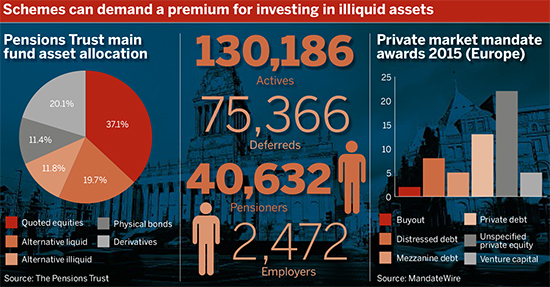Pensions Trust leaps into lending gap with £125m private debt commitment
The Pensions Trust entered the private debt space with a commitment of £125m at the beginning of this year, as it looks to use the withdrawal of banks from the sector to generate growth.
Pension schemes have been active in the private lending space since measures aimed at reducing the amount of leverage banks hold on their balance sheets were introduced in the wake of the 2008 credit crunch.
Schemes are often better able to tolerate illiquidity than other investors and can demand a premium for holding such assets.
It’s important not to expect to be able to deploy money all the time. Investments are found by looking at a large number of potential investments and being selective
Direct exposure
The £7bn Leeds-based multi-employer fund* made the private debt investment, totalling around 2 per cent of its main portfolio, in January of this year. It is the first such allocation for the scheme.
A spokesperson for the trust said the reduction in bank lending has left “a large number of well-run, mid-sized businesses” starved of the capital they require to grow, providing an opportunity for alternative lenders to enter the market.
“The trust has made an allocation to private debt to obtain direct exposure to these businesses as we believe the credit risk associated with this lending offers an attractive risk-adjusted return,” the spokesperson said.
The investment also allows the trust to act on its responsible investment and climate change policies, the spokesperson added, because it enables it “to have some influence over the types of businesses we wish to lend to”.
The Pensions Trust operates a policy of having no more than 20 per cent of the total fund invested in illiquid assets to ensure it does not become a forced seller in times of market stress.
In addition to private debt, the trust is invested in UK property, European unlisted infrastructure and distressed opportunities. It also has an inflation-linked growth fund to gain exposure to long-dated inflation-linked cash flows.
Jo Waldron, director for alternative credit at asset manager M&G Investments, said private debt had traditionally focused on leveraged finance and private placement, but in recent years direct lending has been an increasingly popular theme.
She said: “We’re seeing much more that what we’re doing is working in partnership with banks to make loans to UK companies of all sorts.”
Seeking opportunities
Waldron highlighted schemes’ tolerance for illiquidity as a factor in the growth. “When you’re a pension fund many of your liabilities are very, very long dated… a large proportion won’t come due for a long time.”
Waldron said this meant a large number of funds have decided to keep a proportion of their portfolio in illiquid assets.
She stressed that schemes keen to make these investments must remain patient when looking for opportunities.
“You make money in private debt by collecting interest payments, not by investing in a rising market,” she said.
“It’s important not to expect to be able to deploy money all the time. Investments are found by looking at a large number of potential investments and being selective.”
Phil Irvine, director at PiRho Investment Consulting, said schemes should think about their liquidity requirements before investing in private debt.
“It is absolutely essential that before you go in you are aware of the illiquidity that you are facing and that your portfolio can take it,” he said.
This is especially important to note where a scheme is investing in a fund, rather than doing so directly. Irvine warned that schemes could get returns that are “very stable… until you don’t”.
He said it could be “difficult for an outsider to the fund to recognise a bad-debt situation”.
*The original version of this article described the Pensions Trust as a multi-employer scheme "for voluntary organisations". It also accepts private companies. This has now been corrected.


